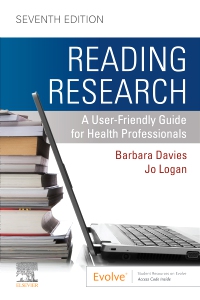
Reading Research Elsevier eBook on VitalSource, 7th Edition
Elsevier eBook on VitalSource

Now $12.59
Learn how to evaluate and apply health sciences research with this beginner’s guide! Reading Research: A User-Friendly Guide for Health Professionals, 7th Edition provides a clear introduction to reading and understanding research articles, with practical guidelines for implementing research into clinical practice. It describes how to interpret common research methods including qualitative, quantitative and mixed-method approaches, and explains how to find relevant, reliable research on the internet. Written by Barbara Davies and Jo Logan, both of whom are noted educators and research experts, this easy-to-use pocket guide is ideal for both students and health professionals.
-
- Concise overview of health sciences-related research maximizes your study time and makes it easier to understand qualitative, quantitative, and mixed-methods research
- Succinct introduction to reading and understanding health sciences research articles is accompanied by practice worksheets and other learning resources on an Evolve website
- Helpful guidelines suggest how to find interesting research results, identify how to use research results towards planning and delivering best practices and improving patient outcomes, and recommend actions to address barriers to using research in practice
- UNIQUE! Tips boxes provide practical, easy-to-follow advice for those who are new to the subject
- UNIQUE! Alert! boxes warn of common assumptions made when reading research
- Recommendations for best practices in research include brief definitions of popular research terms as well as links to World Health Organization information, the latest RNAO (Registered Nurses’ Association of Ontario) Best Practice Guidelines, and guidelines from Australia, the USA, the UK, and other countries
-
- NEW! Enhanced worksheet exercises on the Evolve website demonstrate how to apply knowledge gained from the text, based on research articles drawn from Australia, Canada, Europe, and the USA, on a variety of health issues encountered in hospital and community settings
-
1. INTRODUCTION
Why Read Research Articles?
Some Friendly Advice About Reading Research Articles
Check Out the Reader’s Companion Worksheets
2. EASY STEPS FOR READING RESEARCH
Title Abstract
Introduction
Theory Issues
Methods
Design
Part 1: Qualitative Design Methods
Rigour in Qualitative Studies
Sample and Setting
Data Collection
Data Analysis and Results
Part 2: Quantitative Design Methods
Experimental Designs
Non-Experimental Designs
Rigour in Quantitative Studies
Sample
Data Collection
How to Judge the Rigour of a Data Collection Tool
Sensitivity and Specificity
Data Analysis and Results
Descriptive Statistics
Inferential Statistics
Part 3: Mixed Methods Research
Mixed Methods Study Characteristics
Mixed Methods Data Collection and Analysis
Results and Discussion
A Final Suggestion: The Acknowledgements
3. FINDING INTERESTING RESEARCH RESULTS
Where and How to Start
Define Your Clinical Question
Steps in Constructing a PICO Chart
Search a Database for Relevant Research
Search Terms
How Far Back Should You Search?
Review Articles
How to Read the Fictional Forest Plot Depicting a Meta-Analysis
Appraising Reviews
Searching the Internet for Research Articles
Peer Review
A Cautionary Note About Predatory or Fake Journals on the Internet
How Will I Know If a Journal Is Fake?
Why Should I Be Concerned If the Paper Is Published in a Predatory Journal
Web Portals
Other Types of Databases
Keeping Up to Date
Social Media: Facebook
4. USING RESEARCH RESULTS
Research Utilization
The Questions to Ask
Clinical Practice Guidelines
Appraisal of Guidelines for Research and Evaluation
Practice Guideline Websites
The Decision to Use Research Results
Gathering Support and Resources
Want to Learn More?
Bibliography
Glossary
Journals That Publish Peer-Reviewed Research
Worksheets
1. Qualitative Research: The Reader’s Companion Worksheet
2. Quantitative Research: The Reader’s Companion Worksheet
3. Mixed Methods Research: The Reader’s Companion Worksheet
4. Systematic Reviews: The Reader’s Companion Worksheet
5. Using Research Results: The Reader’s Companion Worksheet


 as described in our
as described in our 